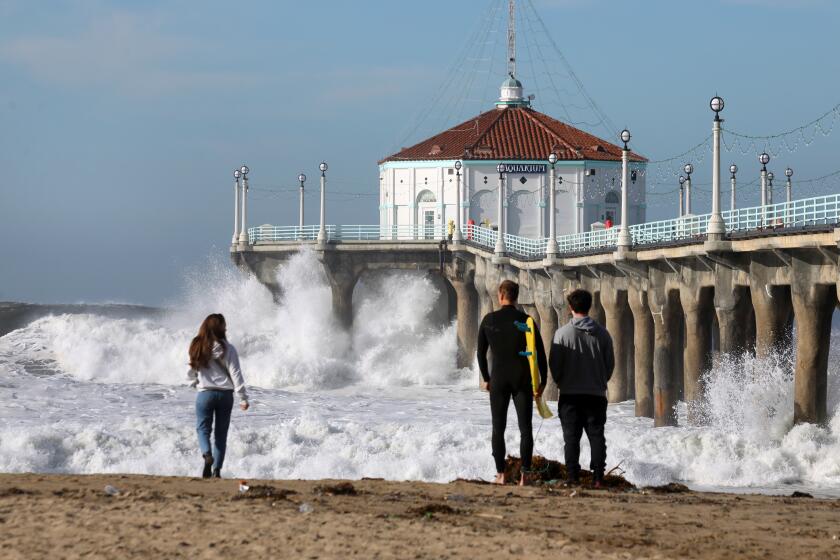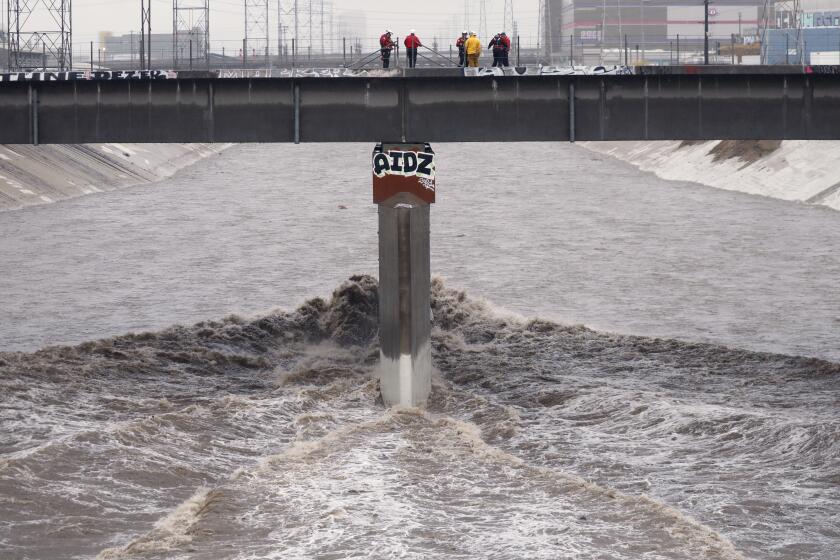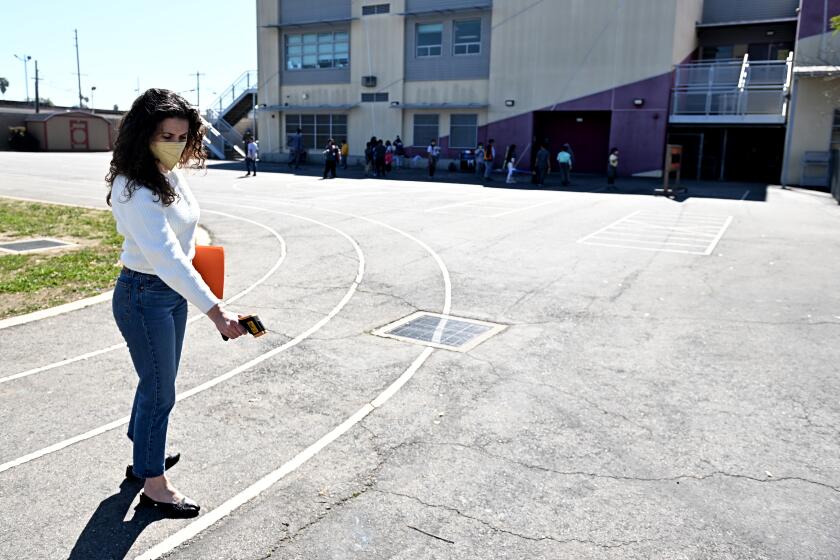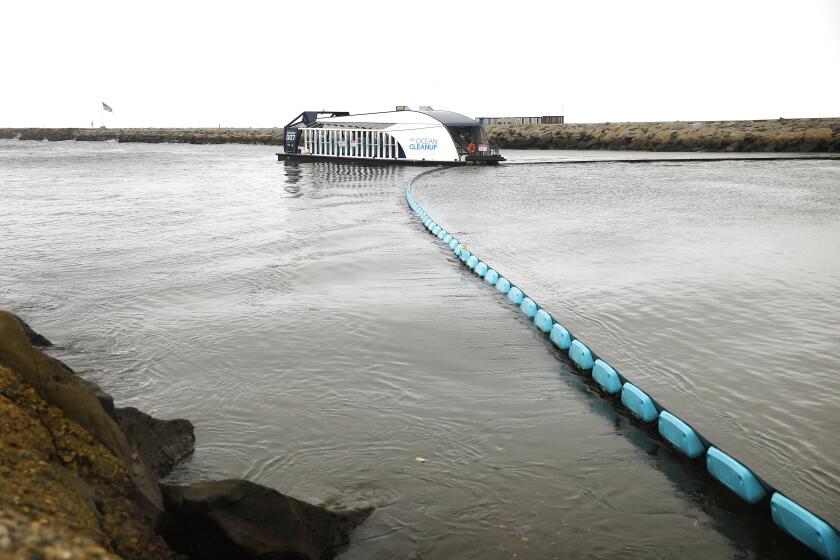L.A. promised to stop wasting so much stormwater. But progress has been painfully slow
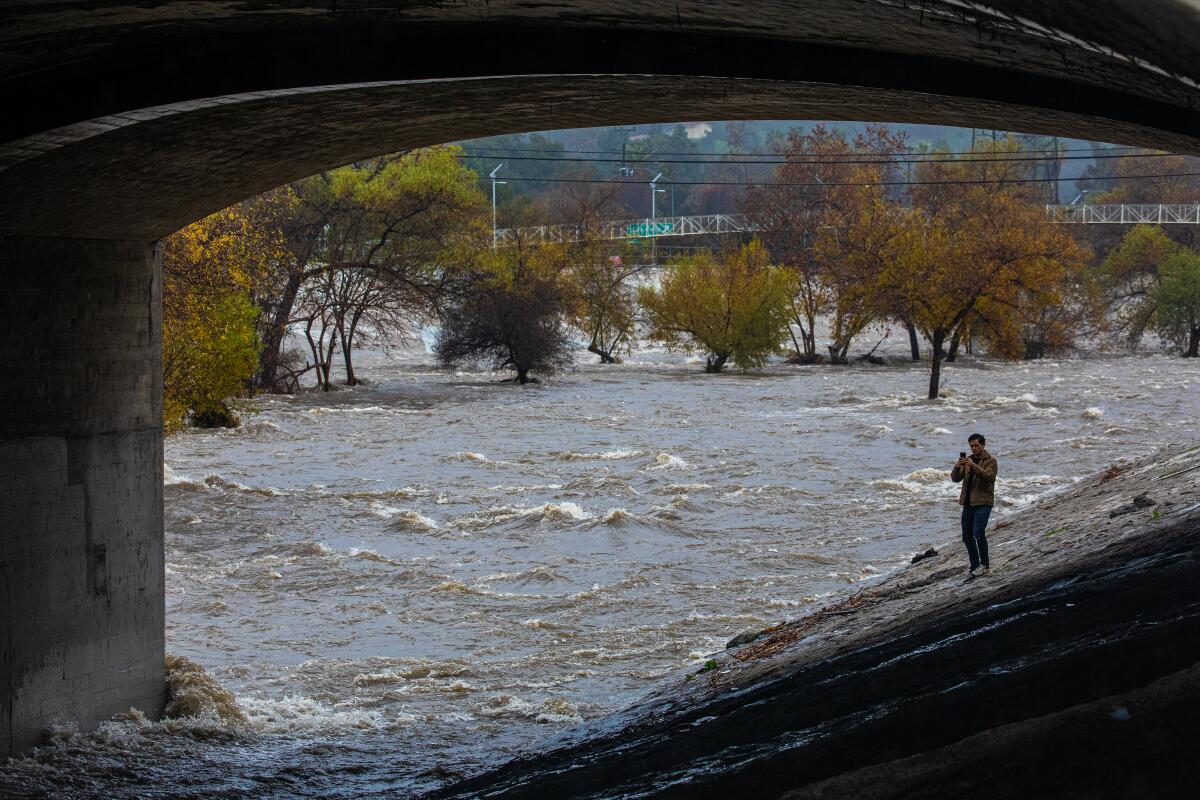
- Share via
Only weeks ago, Angelenos watched as trillions of gallons of precious stormwater poured into the region’s concrete waterways, slid down slick pavement and washed out to sea. After so many months of drought-related water restrictions, it seemed to many like a missed opportunity.
While officials say they’re making progress when it comes to capturing more of the county’s stormwater, a new report from watchdog group Los Angeles Waterkeeper has focused on the plan’s sluggish progress so far, and calls for improved metrics and a more proactive approach, among other recommendations.
The Safe Clean Water Program — passed by Los Angeles County voters in 2018 as Measure W — allocates $280 million annually to projects aimed at capturing and cleaning stormwater when it falls. That includes reducing the amount of asphalt and hardscape that now prevents water from percolating into the earth.
But three years in, only 30 acres of new green space have been added under the program, the report found. Los Angeles County spans about 3 million acres.
“What you see is largely a bunch of really small- to medium-sized projects that are not moving the needle in a substantial way on both water quality standards attainment and water supply,” said Mark Gold, director of Water Scarcity Solutions for the Natural Resources Defense Council. “That lack of strategic vision — and how are we actually going to get there — is something that’s incredibly concerning.”
As California is pummeled by a string of atmospheric rivers, efforts to capture and treat stormwater face many hurdles.
The L.A. Waterkeeper report focuses on Safe Clean Water’s regional program, which includes 85 cities and unincorporated areas within the county’s flood control district. The program awards projects primarily through a competitive grant process, but applications for such projects have slowed during the first three years, and the approved projects are getting smaller, the report found.
That’s probably because the initial burst of applications consisted largely of shovel-ready projects that just needed funding, said Bruce Reznik, executive director of L.A. Waterkeeper. Once that backlog was cleared, proposals shifted toward other projects in slower stages of development.
“They hit a lot of the low-hanging fruit, and that makes perfect sense for where we are,” Reznik said. “But the lack of hardscape removal is definitely troubling, and that jumps out.”
Indeed, the best way to capture more stormwater — and to prevent more polluted water from reaching the ocean — is to increase green space, the report says. Soil and other permeable surfaces act as natural filters for toxins and allow stormwater to seep into the ground, replenishing the basins that form the foundation of local water supplies.
Currently, a large portion of the county, including most rivers, creeks and streams, are lined with concrete to whisk water away, including about 80% of runoff from every rainfall. That’s a boon for flood control but not so much for stormwater capture.
Reznik and others who championed Measure W lauded the county for getting the massive program off the ground, but said its next phase could benefit from a more proactive approach that is less reliant on the cumbersome grant application process, which can favor larger entities with more resources.
“It makes a lot of sense that we need to think about individual projects and how to make them great, but we also need to think about how those projects knit together across the county,” said Lauren Ahkiam, co-chair of the program’s Regional Oversight Committee.
Of the 101 infrastructure projects funded in the program’s first three years, 64 came from cities — including 18 from Los Angeles — and 20 came from unincorporated areas of L.A. County, according to the report. Only 17 came from other entities, such as watershed management groups and nongovernmental organizations.
In 2018, L.A. County voters approved Measure W, a massive tax aimed at protecting beaches and improving water supply through storm water capture. Yet only $95.5 million has been disbursed for projects out of $556 million collected.
There’s also the challenge of working around the region’s built environment. It’s easier to improve an existing park, for example, than it is to find space for a new one, which could involve acquiring new land, remediating an open area that may suffer from some sort of contamination, also called a brownfield, or other larger efforts.
“Maybe there’s a lack of creativity, just falling back on the tried-and-true park retrofit projects,” said Reznik. “They’re good projects — a lot of these parks needed rehabilitation — but we just can’t only be doing that.”
According to the report, 41 of the 101 projects involved the rehabilitation of existing parks. Only three were new parks.
Some aspects of the program are working, however, and the report identifies about 20 projects it rates as exemplary. One such project, Urban Orchard, converted a brownfield in South Gate into an 8-acre park that helps capture and treat stormwater runoff along the L.A. River.
Another, the Rory M. Shaw Wetlands Park Project in Sun Valley, will convert a 46-acre landfill into a wetlands park that can collect stormwater runoff. The project will capture 32,351 acre-feet of water a year, or enough to supply about 356,000 residents using 80 gallons or less per day. The wetlands will also incorporate native vegetation and create a habitat for wildlife in the area.
Still, there is work to be done — particularly around schools. Many schools in Los Angeles are blanketed in asphalt, including campuses in polluted and park-poor communities. That can contribute to an urban heat island effect that is both dangerous for students and useless for water capture.
Yet only one of 10 proposals submitted by the Los Angeles Unified School District was able to secure funding through the Safe Clean Water Program, the report found, and that project was later withdrawn.
Ahkiam said that because LAUSD is one of the region’s largest landholders, schools represent a “real opportunity” for stormwater capture, but legal and bureaucratic hurdles, as well as overstretched resources, have made it hard to get some of that work going.
“There’s a good opportunity to get that information out more — for different cities to understand what’s possible, and different parts of the public to understand what stormwater capture can look like, and how it can be woven into so much of our infrastructure,” she said.
Some schools have taken advantage of the program. Jackson Elementary in Altadena worked with the nonprofit Amigos de los Rios to secure funding for the removal of 21,000 square feet of asphalt and concrete. In its place, they installed planters, bioswales and permeable pavement to help improve drainage and conserve water.
“Every school is a microcosm of the bigger watershed,” said Claire Robinson, managing director of Amigos de los Rios. “It’s very empowering to have students transforming their own campuses and learning in real time what it is to capture and protect water quality.”
Children shouldn’t be forced to learn and play in hot, asphalt-covered, fenced-in campuses, especially in neighborhoods that already lack park space.
Despite such opportunities, the report notes that a lack of clear metrics and definitions for evaluating projects has led to uncertainty about some outcomes. While 92 of the 101 regional projects funded in the first three rounds provide some water supply benefits, it’s unclear whether and when all of those benefits will be fully realized.
What’s more, a one-size-fits-all approach can make it harder for some projects to get approved, since the same criteria doesn’t always make sense across different watersheds. Infrastructure projects, for example, must score 60 points according to a formula that takes into account water quality benefits, water supply benefits and other factors in order to be eligible for funding.
Reznik said he’d like to see more of the funds used to improve outreach, education, community engagement and workforce development — aspects of the program that have yet to “roll out in any comprehensive way.”
He hoped the report’s release, which comes in the wake of January’s major storms and ahead of a biennial review from the Regional Oversight Committee, could help shape the next chapter of the work.
“This is actually a really good time for us to sort of take a deep breath, look at what’s been accomplished and look at how we can make the program work even better moving forward,” he said.
Angelenos are also invested in the program’s success. Nearly 70% of L.A. County voters approved Measure W in 2018, which allows the county to levy a parcel tax of 2.5 cents per square foot of impermeable space. A typical homeowner pays between $50 to $125 per year, while large commercial spaces with parking lots could pay as much as $10,000.
The atmospheric river storm hitting California this week presents a test for an experimental waste-capturing system that’s intended to keep plastic bottles, diapers and other trash from flowing into the Pacific.
“It’s encouraging to see that the L.A. Waterkeeper and others recognize the complexity of a regional program like Safe Clean Water and its accomplishments to date,” L.A. County Public Works Director Mark Pestrella said in a statement. “We also recognize there are opportunities to enhance the program and will continue to work with stakeholders to adaptively manage and improve it — while seeking funds from a variety of other sources to speed its full implementation.”
Pestrella said the county has captured nearly 50 billion gallons of stormwater through its network of dams, reservoirs and spreading grounds since last October alone. Improvements through the Safe Clean Water Program over the next five years will conserve another 18.5 billion gallons, or “enough to fill the Rose Bowl 219 times,” he said.
Yet Gold compared the Safe Clean Water Program to Measure M, a transit tax that he said is less focused on piecemeal projects and more on long-term plans.
“That’s what’s missing from Measure W in a big way. If you know you’re getting revenue of $280 million a year in perpetuity, then you can start taking the long view on these bigger, more transformational projects,” he said. He added that he’d like to see stormwater capture incorporated into every transit project moving forward.
“We’ve learned a lot in the first few years, and it’s just time to get more strategic and more visionary in what we’re achieving with this unprecedented program,” he said. “This literally has the opportunity to be transformational.”
More to Read
Sign up for Essential California
The most important California stories and recommendations in your inbox every morning.
You may occasionally receive promotional content from the Los Angeles Times.
